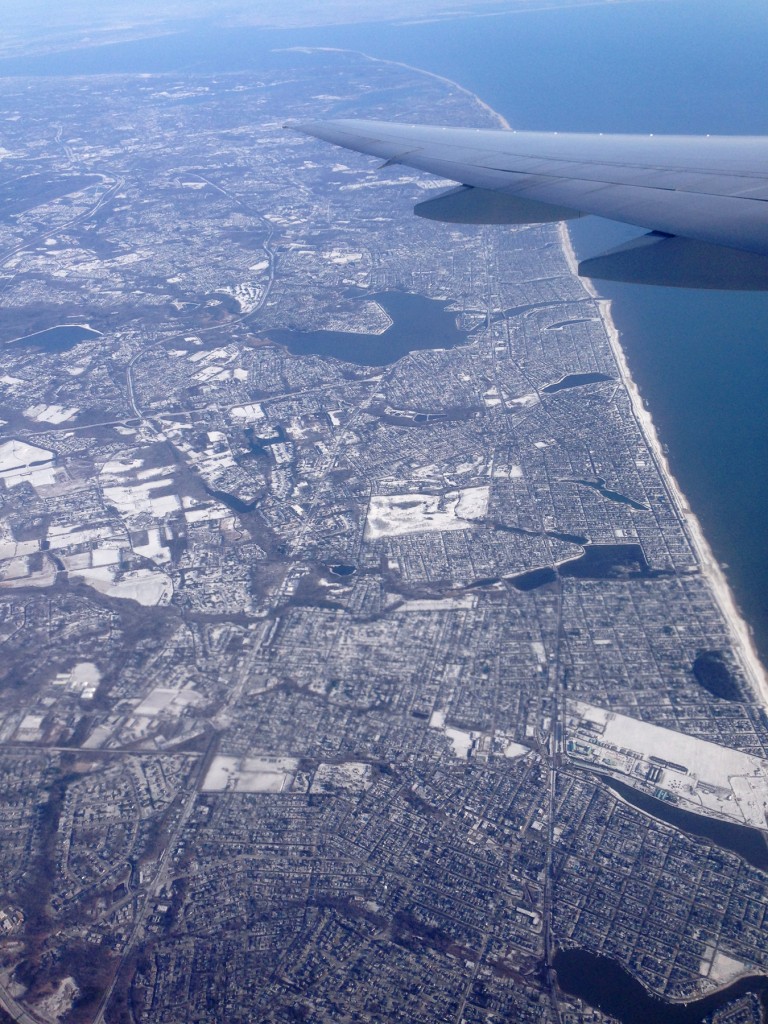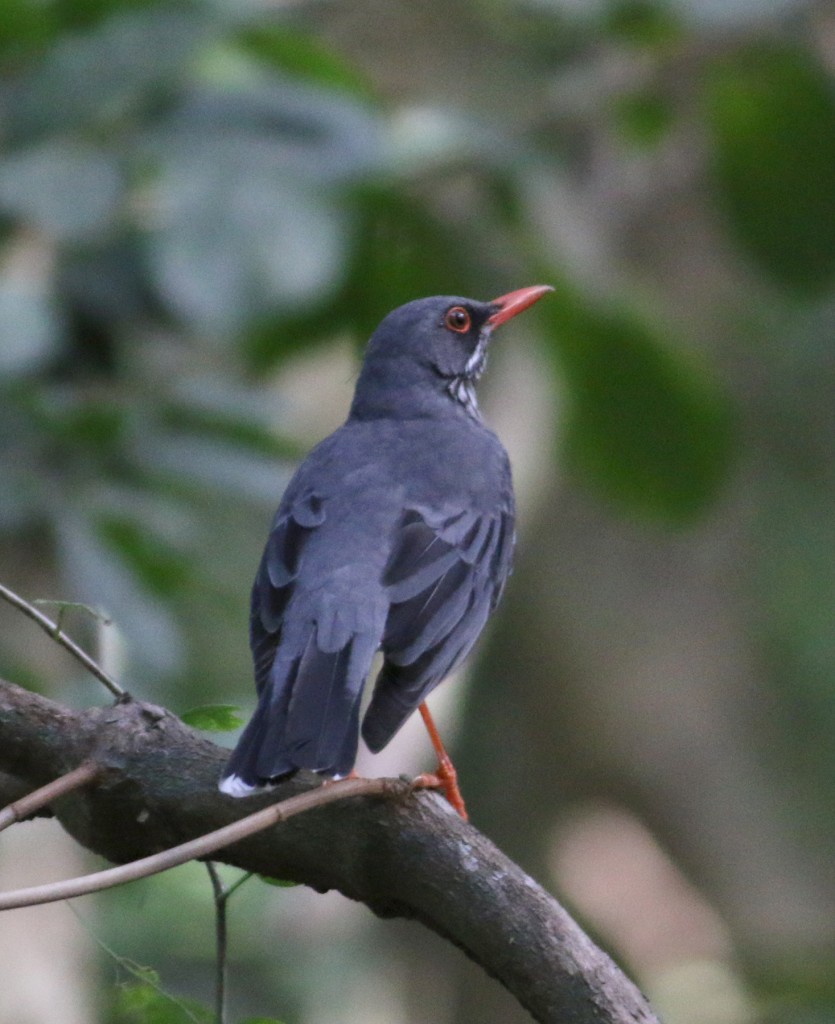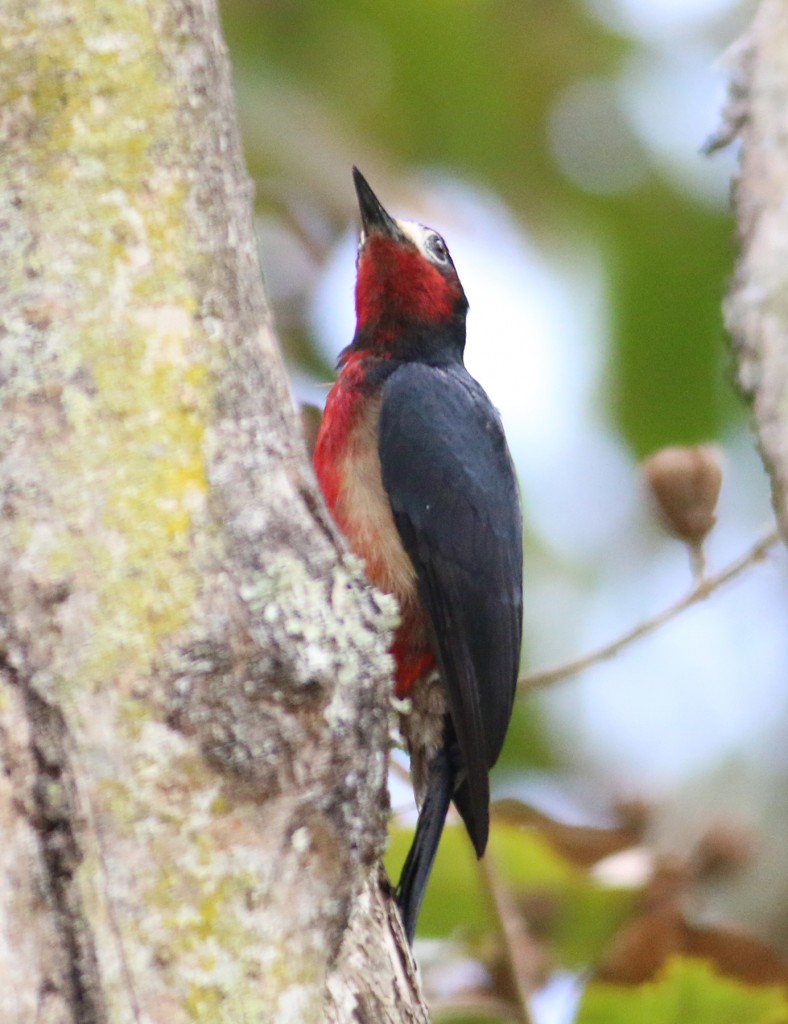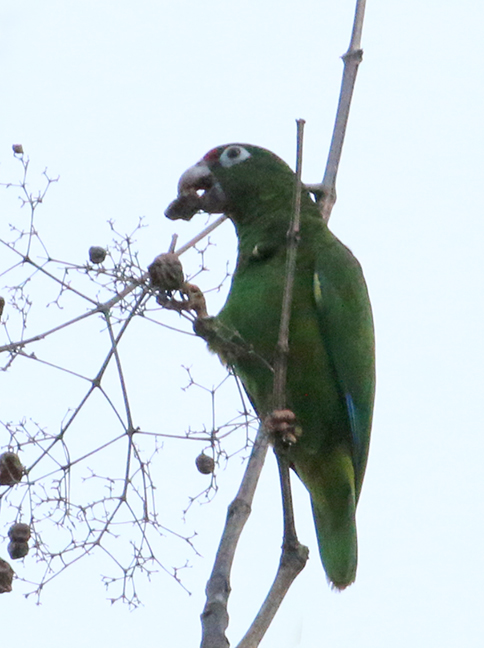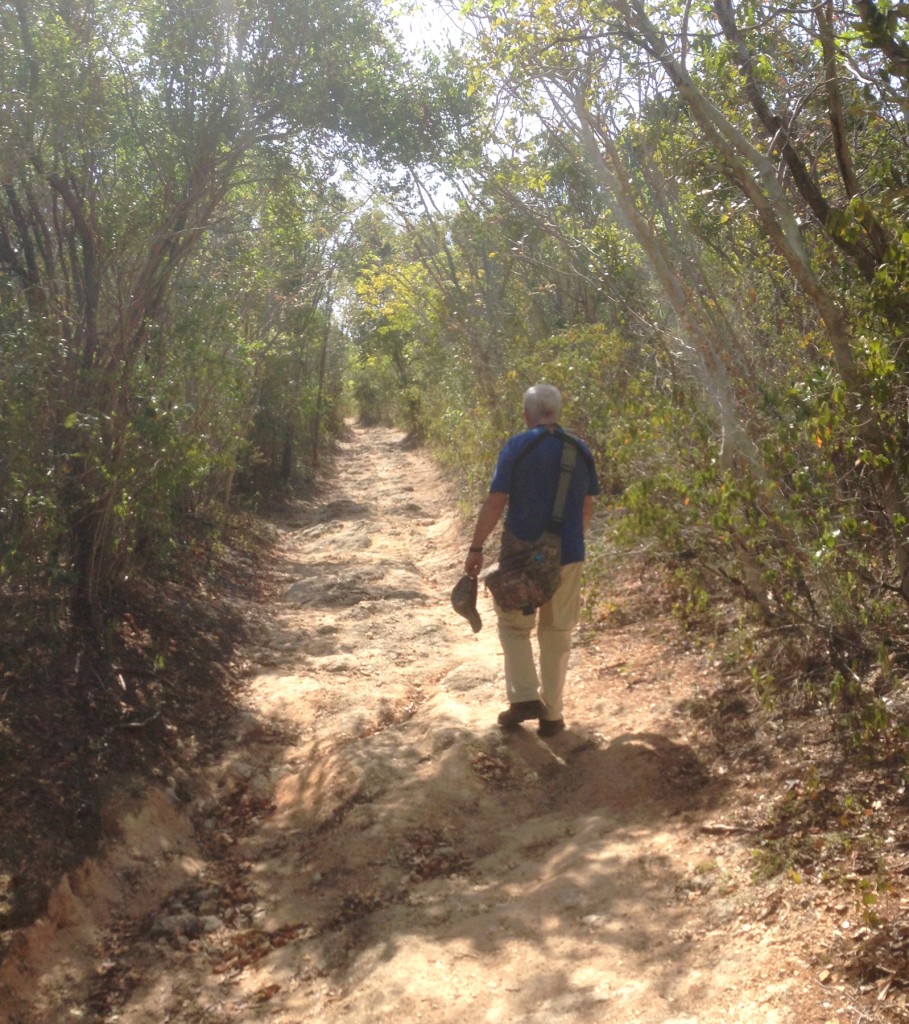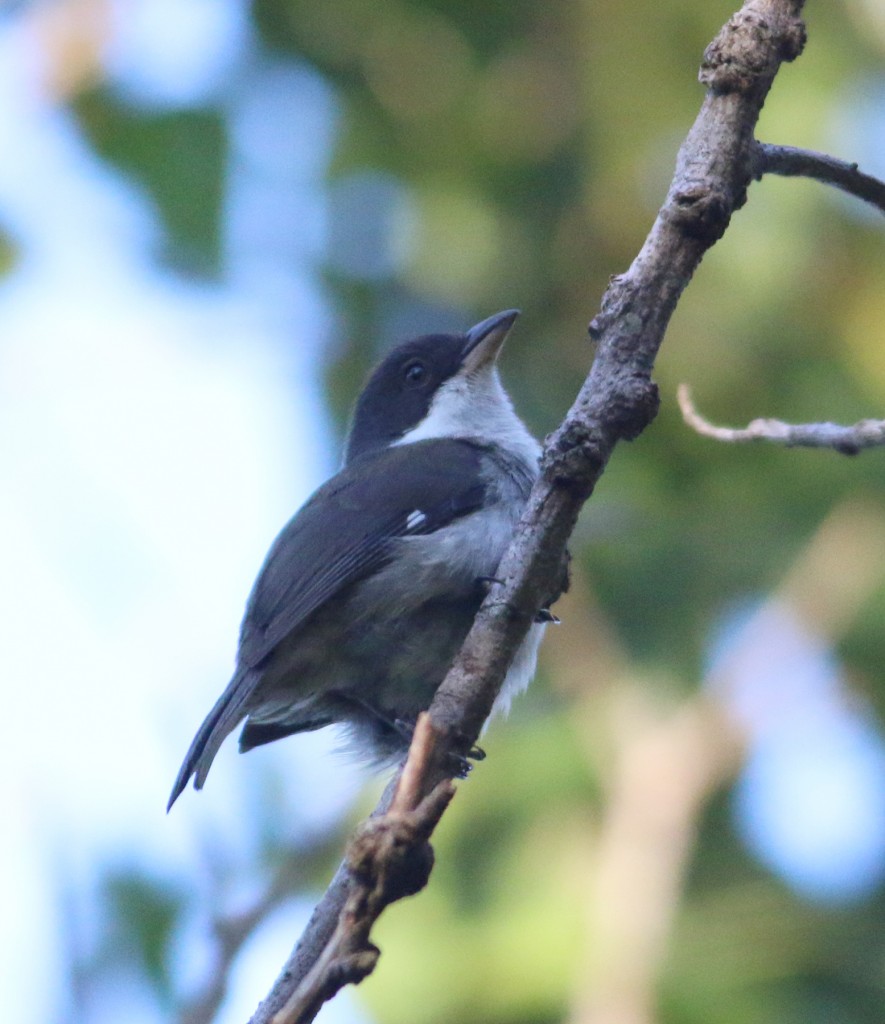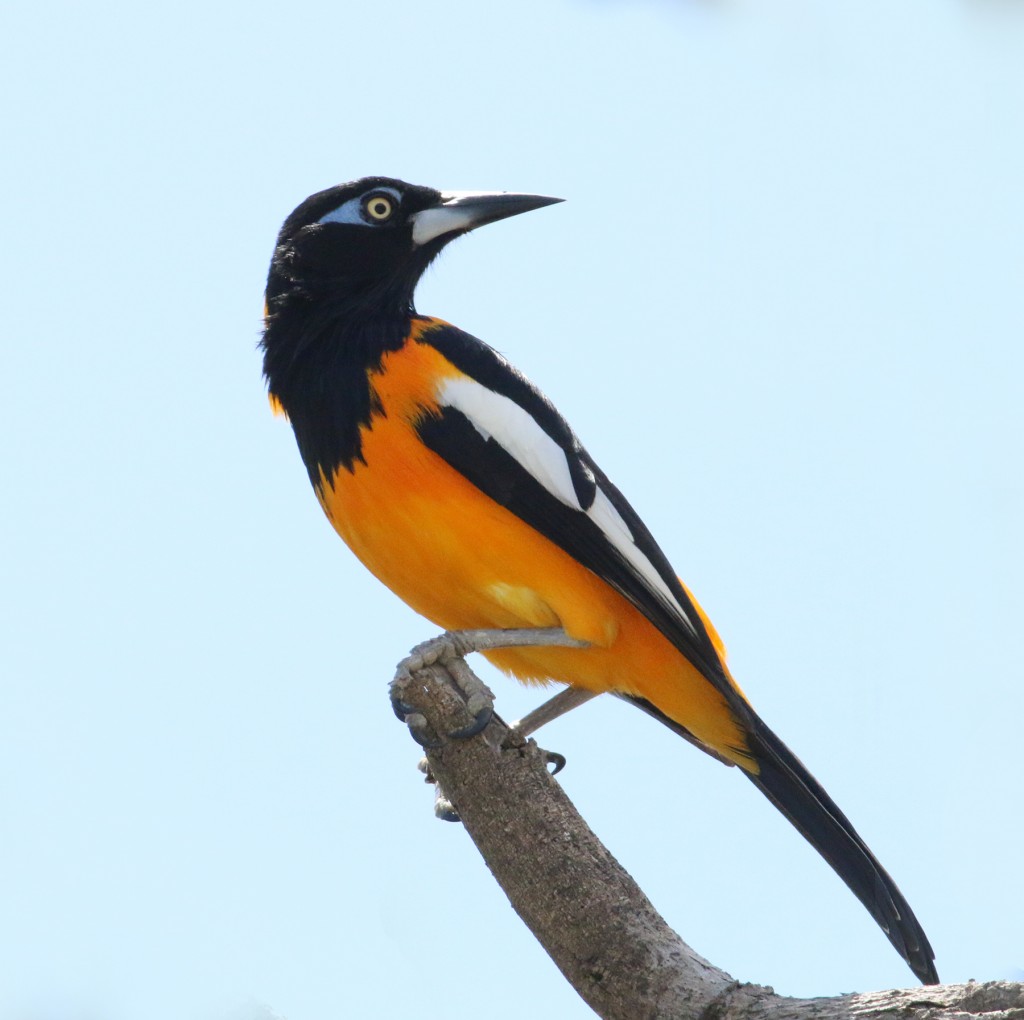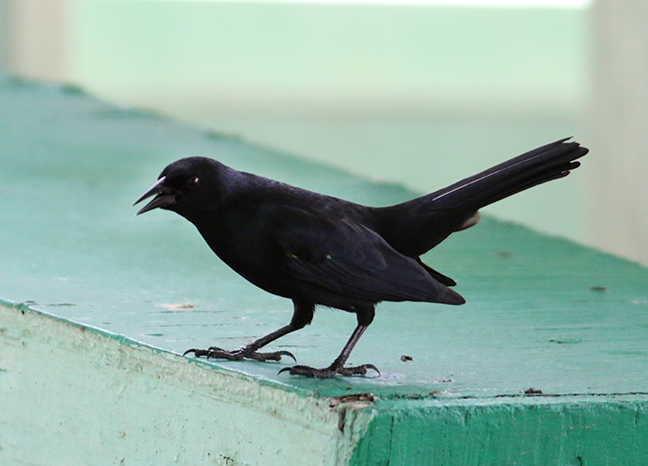Puerto Rico birding trip March 16 – March 22, 2017
OK, get ready; this is going to be a long post, so I decided to divide it into two sections. The Birdquiz.net crew (me along with brother Rich) just returned from a six-day birding trip to Puerto Rico. We were very fortunate on this trip; the March weather in New Jersey took a strong downturn just before we left and continued while we were gone. In Puerto Rico, by contrast, the temperatures hovered around a high of 85 degrees every day, with comfortable temperatures at night. It always feels like a treat escaping nasty weather, doesn’t it?
Let’s start with an obvious question: why go birding in Puerto Rico when there are many other destinations with more species? For example, according to Wikipedia Puerto Rico has a bird list of 349 species (of which 166 are accidental) while Panama has a list of 992 bird species. Yet Puerto Rico has several advantages. It is a relatively small island, only ~100 miles from east-to west, and 35 miles from north to south, so it is easy to sample all the habitats and find most of the key species in just five or six days. Second, there are 17 endemic species and a few Caribbean specialties that together constitute a nice target list of ~50 species. That’s not bad for a small island. Third, because Puerto Rico is part of the US, it is extremely convenient for US birders. For Americans no currency exchange is necessary, phone service is covered on our US phone plans (allowing GPS navigation in the rental car), passports are not required, and many residents speak English. All of that makes it very easy to arrange a do-it-yourself birding tour. To top it off we found a 3 1/2 hr non-stop flight from Newark for only $286. Offsetting those advantages is the absence of several tropical families such as antbirds, toucans, woodcreepers, trogons, and cotingas that can be found in Central American and South American countries. Well, you can’t have everything.
The Trip (part 1)
Day 1: We land in San Juan in early afternoon, so our opportunities for the day are limited. Most of the best birding spots are located in the central or southwestern parts of the island, where it also conveniently is much drier (less chance to lose birding days due to rain). We did not want to spend time in the city, so we rented a car (from Hertz…a 1 1/2 hr wait…don’t get me started!), and drove 1 hr westward, stopping at Calambache State Forest. Just outside the park we had our first lifer, a colorful Venezuelan Troupial that was easy to spot even at 40 mph. The park itself has nice wide trails that seem to be used more by mountain bikers, where among the birds we were able to see a group of widely distributed and common endemics that we were later to find at nearly all of our stops: Puerto Rican Woodpecker, Red-legged Thrush, and Puerto Rican Tody. It was a nice start. We had time for one more stop before dark, so we headed to a roadside pond near Camuy that was filled with very nice birdage. The first bird that we saw was our main target; a gorgeous bright pink American Flamingo that conveniently was on the nearest shore. Wow. What made it even better was the 50 or so White-cheeked Pintails (another lifer) and more than 100 Black-necked Stilts that were surrounding it. The pond held other goodies, including Least Grebe, Common Gallinules, and the Caribbean white-shielded version of American Coot that used to be a separate species before being lumped with the ‘standard’ American Coot. Now that’s what I call a nice roadside stop. It was a great start for the trip.
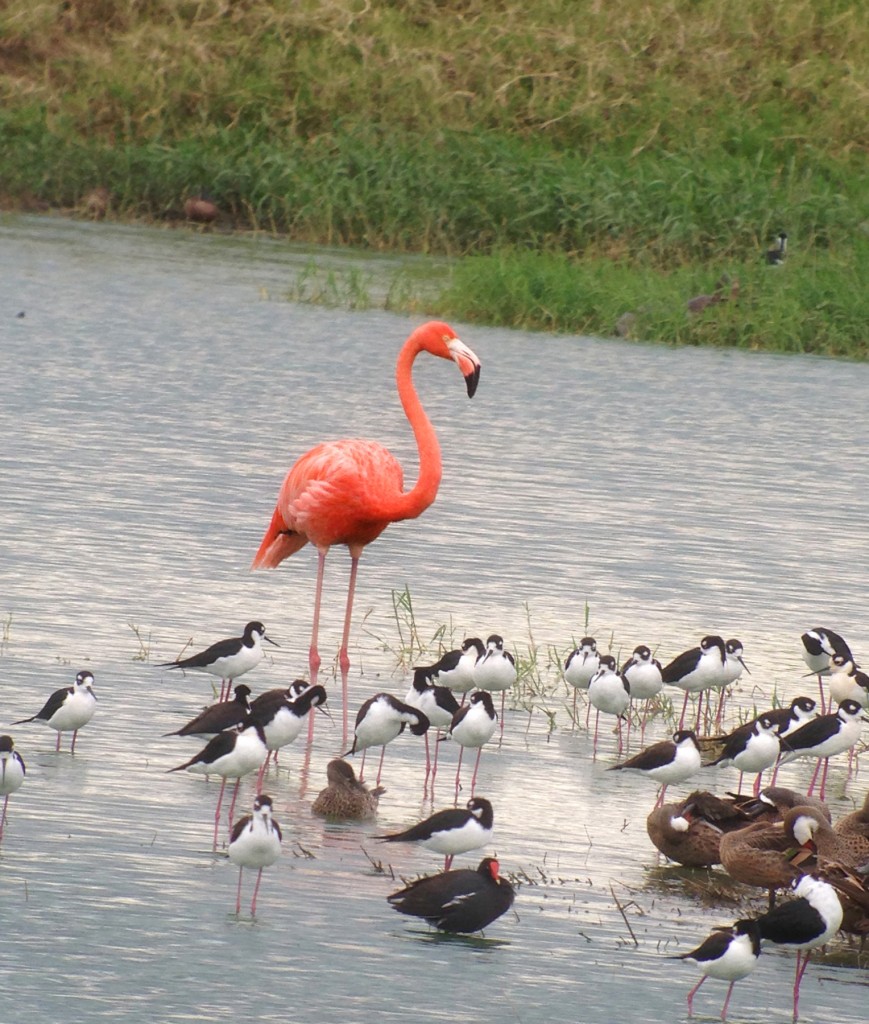
An American Flamingo that has appeared at the same location near Camuy for at least three years, surrounded here by Black-necked Stilts, Common Gallinule, and White-cheeked Pintails.
Day 2: Today started with a 30 minute drive southward to Rio Abajo State Forest. The main target here is the rarest bird on the island, the endangered Puerto Rican Parrot, with perhaps only ~200 birds in the wild. The parrots are being bred at Rio Abajo and released there and elsewhere. A minute after we exited the car we flushed a Ruddy Quail-dove, a species that I did not expect to see on this trip. The ‘trail’ beyond a locked gate at Rio Abajo is a paved road that is relatively level, comfortable, and convenient, and just a mile or so away from where the breeding facility is located. Before we even reached that area, however, we heard a few parrots flying overhead. Somehow we were able to spot one that landed and get a clear view. One quick photo and then the birds flew off again. Later on we saw another one in flight and heard more flying the area. What a treat. There were plenty of other birds to keep us busy at Rio Abajo, including endemic Puerto Rican Vireo, Puerto Rican Bullfinch, Puerto Rican Spindalis, Loggerhead Kingbird, and Puerto Rican Lizard-cuckoo. For fans of Todies, this was a super location, with at least 25 Puerto Rican Todies being seen here. It certainly helped once we became familiar with their calls. Rio Abajo SF was one of the highlight locations on this trip for us, and is highly recommended.
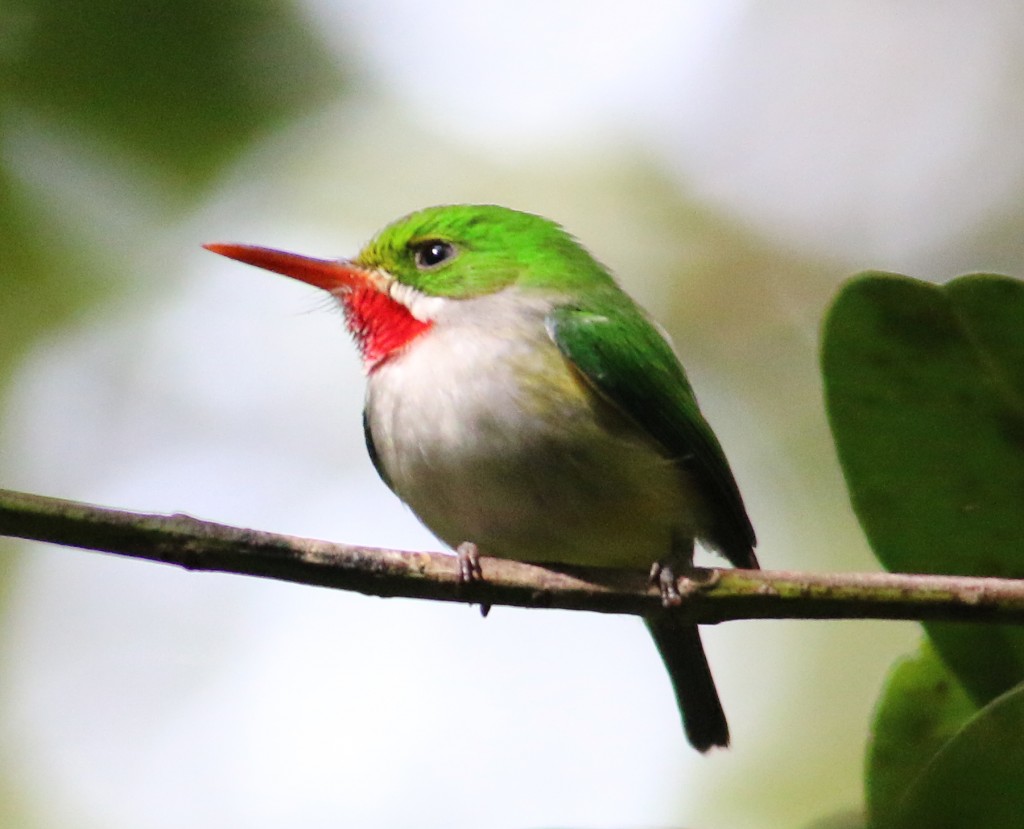
Puerto Rican Tody. How can you not like this tiny bird? Before departing for this trip I was wondering if I’d be able to see any, but thankfully, they were easy to find all over the island.
Next we drove at least 2 hours southwest for a short mid-day stop at Guanica State Forest. Guanica is a ‘must’ location for a PR birding vacation, because Puerto Rican Screech-owls and Puerto Rican Nightjars can be heard and sometimes seen here. We’ll return to those species later, but because Guanica is a very dry and hot location, birding is best done here in early morning. Even on this mid-day walk, however, we were able to spot several endemic Pearly-eyed Thrashers near the visitor parking lot, accompanied by Adelaide’s Warblers (which we were to see later at a few other locations, but most frequently here) and a Puerto Rican Emerald that was feeding on a stalk of yellow flowers. We settled into our hotel in Parguera which was to be our base for the next three days (or so we thought).
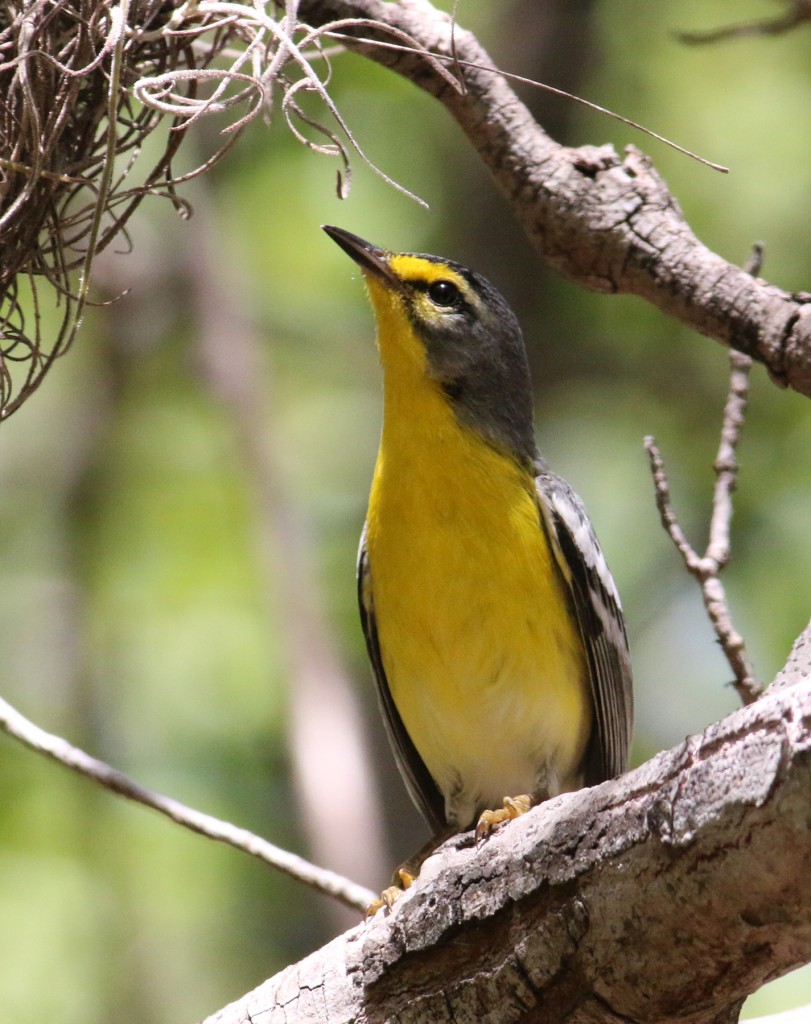
Adelaide’s Warbler, a species that we saw best at Guanica, but after becoming familiar with their loud trilling song, we were better equipped to find it at other locations.
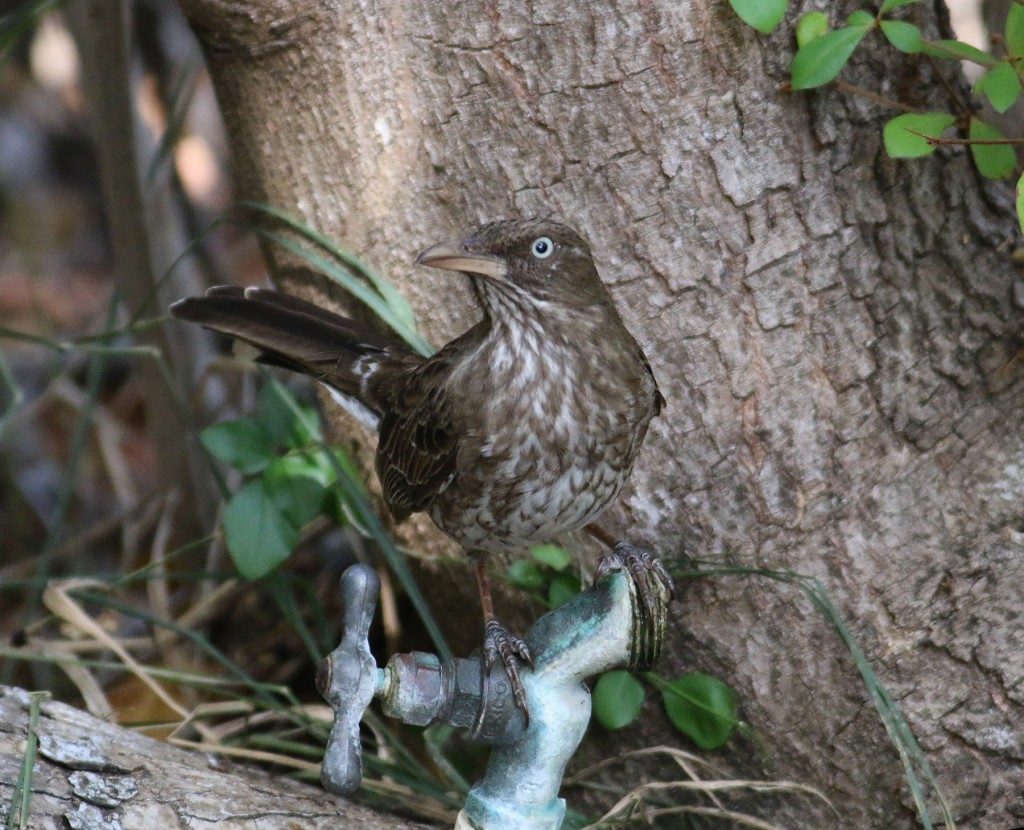
This Pearly-eyed Thrasher stayed at this faucet for a while, like it was defending its water source in the hot and dry Guanica Forest.
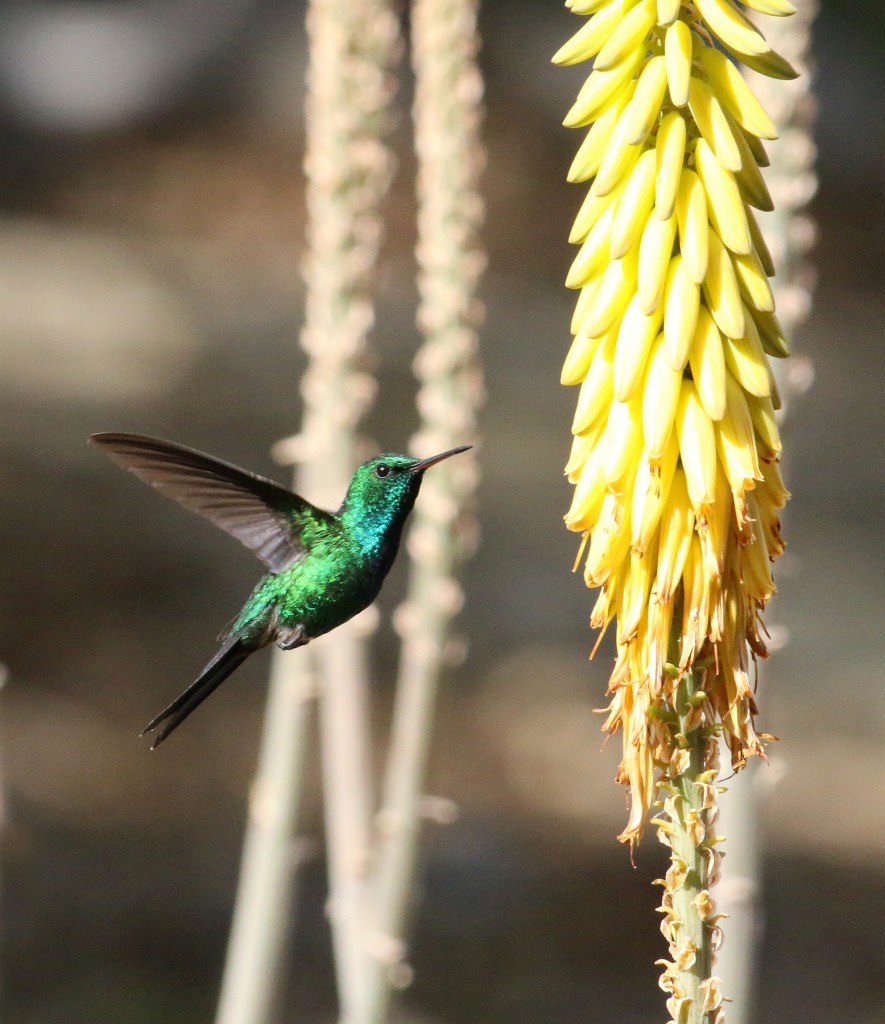
If you find the flowers, you’ll find the hummingbirds. This Puerto Rican Emerald fed on most of the flowers in this stalk for a few minutes. Note the deeply forked tail that helps distinguish it from the five other hummingbirds found in Puerto Rico.
Day 3: Our main location this morning was Maricao State Forest, which is in the mountains about 1 hour north of Parguera, reached by a winding 1 1/2-lane road. The main targets here are the highland specialties, and we did well in finding them. We saw Puerto Rican Tanagers in several small groups along the main trail at km 16.8 of Rte 120. I was able to get one quick better-look-desired at an Antillean Euphonia. Our main target was proving elusive, however. We were trying to find the Elfin-woods Warbler, a species that was first described in 1972. It looks similar to the more familiar Black-and-white Warbler, but with black cheeks. After trying a few other trails, we returned to the km 16.8 trail, and a little further on from where we turned back in the morning Rich spotted the first one just off the trail. I was unable to get a photo because these birds are much more active than the B&W Warbler, which tends to forage deliberately on trunks and branches. The Elfin-woods Warbler was calling and flitting actively from branch-to-branch. Our final endemic at Maricao was a single Green Mango hummingbird that Rich spotted perched above the trail. One genuine surprise that we had here was a Key West Quail-dove that flushed from near our feet. We were able to re-find it in the dense brush, where it froze for a minute or two. So we were fortunate with two tough-to-find Quail-doves on this trip. Although we did well seeing the highland specialties here, overall we were disappointed with Maricao due to the limited trails and because it was less birdy than some of the other locations that we visited.
For the afternoon, we drove to the furthest southwest corner of the island, to a beautiful park called Cabo Rojo, that has a gorgeous beach, a scenic cliffside trail, and an adjacent National Wildlife Refuge containing salt ponds and mangrove flats. We were hoping for extensive shorebird flocks on the flats, but being the dry season, much of the flats were bone dry, so we didn’t spend much time sorting through the few shorebirds here. We did spot Brown Boobies perched on the cliffs and flying by, had a nice view of a White-tailed Tropicbird, and enjoyed a very cooperative Venezuelean Troupial near the parking area. We stopped at a roadside eatery just outside the park, and while eating some home-cooked empanadillas, Rich spotted another target, the endemic and threatened Yellow-shouldered Blackbird coming out of the mangroves. I was thrilled to see them here, because many birders resort to finding them in downtown Parguera where they feed on handouts behind a store. That just seems wrong, but seeing them near these mangroves while eating lunch was a bit nicer.
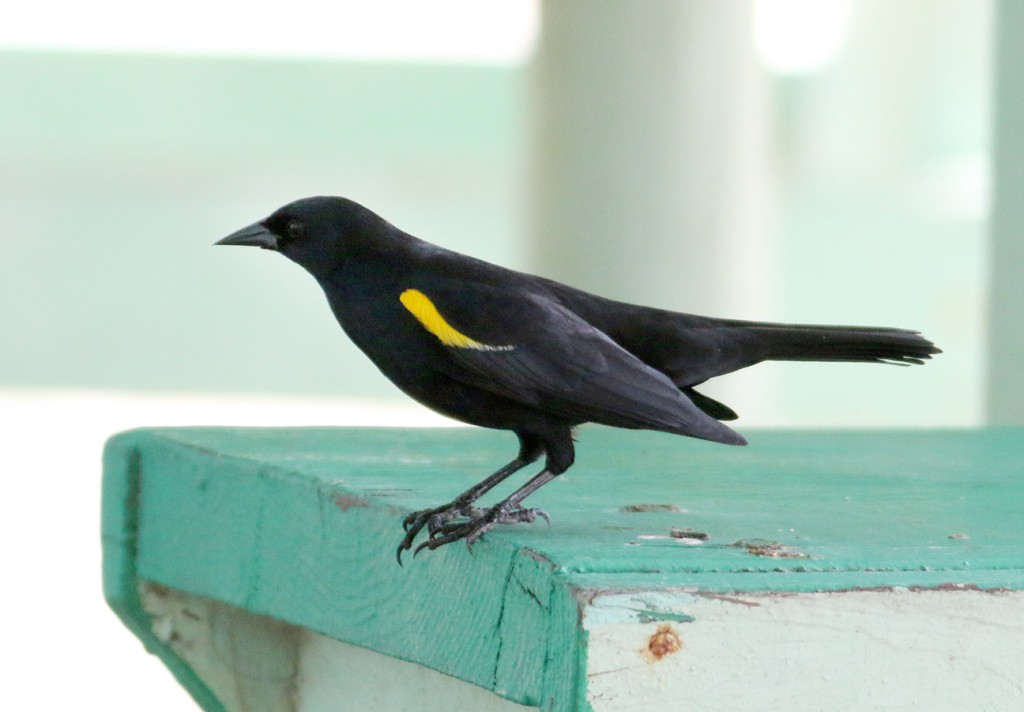
A Yellow-shouldered Blackbird that popped out of the mangroves, presumably hoping for some empanadilla handouts.
Continue on to part 2 of the trip by clicking here.
